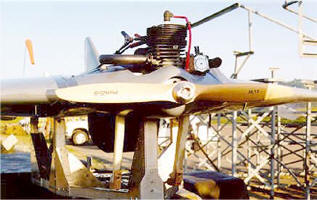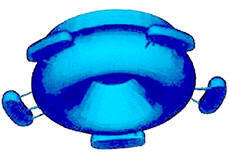|
Home | Issues |
Articles |
Experimental Aviation Glossary |
Video Hints for Homebuilders |
Q&A |
A Personal View |
Polls
08/08 - Is
there a Spark Ignited Heavy Fuel Engine in your future?
By Anthony J. Liberatore
Images courtesy www.sonexresearch.com
Imagine with today’s fuel prices, you are able to
pull your aircraft up to the Jet A pump to save a little on your fuel bills. The
concept is tantalizing, although I have been told it is nothing new. In order to
help the war effort during WWII, some farmers would switch over to kerosene
after getting the engine on their tractor warmed up. With a new war effort
underway, a new military requirement has emerged that is a technology driver.
This requirement is that all GPU’s, UAV’s, etc, with small engines, must run on
JP-5 by 2010, in order to eliminate the logistics of carrying different fuel
types into a theatre.
This requirement is driving a number of
manufacturers and Two Stroke 100cc powered UAV converted to
run entrepreneurs to use their creativity and come up on JP-5 for the U.S. Marines.
solutions to fill this need. Some of the
current entries
with some
unique solutions are Evan Guy Enterprises, Dan Gurney
(of racing fame), Sonex Research Inc. (not to be confused with Sonex Ltd, the
kitplane manufacturer), and Mercury Marine. While there are some true diesels
such as the Deltahawk that are trying to fit in and fill a given role as an UAV
engine, the thrust of many of these innovators is to modify existing engines to
run on “heavy fuels”. With that said we might never see general aviation
applications for a long time if at all. In fact with today’ s emission
regulations, any application outside the military may never come to fruition.
Nevertheless, the concept is so tantalizing we cannot help but dream of what an
engine this would make for our aircraft.
What they have created with these “spark ignited
heavy fuel engines” is an engine that can burn a diesel type fuel without the
high diesel compression ratios normally needed for the combustion process, and
without the associated high engine weight required for strength. It gets
even more enticing; many of the engines they are converting are two strokes,
which are even lighter than the small certified engines we are accustomed too.
|
With that said, I would like to discuss two of the
entrants and their interesting technological solutions.
One of the entrants is a company out of Annapolis, Maryland: Sonex Research Inc.
Sonex’s unique and patented approach uses a design that can be applied to the
cylinder head or the piston. This design utilizes a center chamber that has a
series of smaller chambers surrounding it (see image to the right). The outer
chambers are connected to the center chamber via individual passageways. A
current application of Sonex’s technology in the field is a number of 2-Stroke
100cc powered UAV’s converted to run on JP-5 for the U.S. Marines. (see photo
below) Sonex has two variations of there technology still in the R & D mode.
With these variations, one is touted to make diesels run cleaner and the second
|
 |
|
could allow the elimination of a spark source when
direct fuel injection is used while at the same time allow heavy fuel
use. Note this is a small and relatively new firm and many of these
projects still may need some maturation. |
Another interesting entry in this arena is the
“Optimax JP” outboard engine by Mercury Marine. Mercury Marine is developing an
outboard and a “jet” (both in the 200+hp class) for Navy “Seal” use. This
Optimax JP is a derivative of their successful Optimax Series of outboard
motors, which range from 75 hp up to 250 hp, and are direct injected two
strokes. Direct injection applied to a two stroke gives the engine its inherent
light weight, with 4-stroke fuel consumption and emissions, as well as a more
robust lower end, since the crank and rods bearings are not exposed to fuel
diluted oil. These direct injected two stokes utilize Orbital Engine’s air
assisted direct injection technology which atomizes the fuel droplets down to 8
microns, which is the industry benchmark. The flexibility of this system allows
Mercury Marine to convert the engine to heavy fuel while maintaining 95% part
compatibility with their gas burning brethren.
As you might garner, what is going on in this arena
is definitely on the cutting edge. However, we as aviators and experimenters
have always been on that edge when it comes to applying technologies. Perhaps a
two stroke direct injected, spark ignited heavy fuel engine, with an excellent
power to weight ratio and great fuel consumption specifics would drive a new
generation of airframe designs. Not to mention it would be neat to taxi to the
jet A fuel pump and filler up!
Comment on this article:
|


